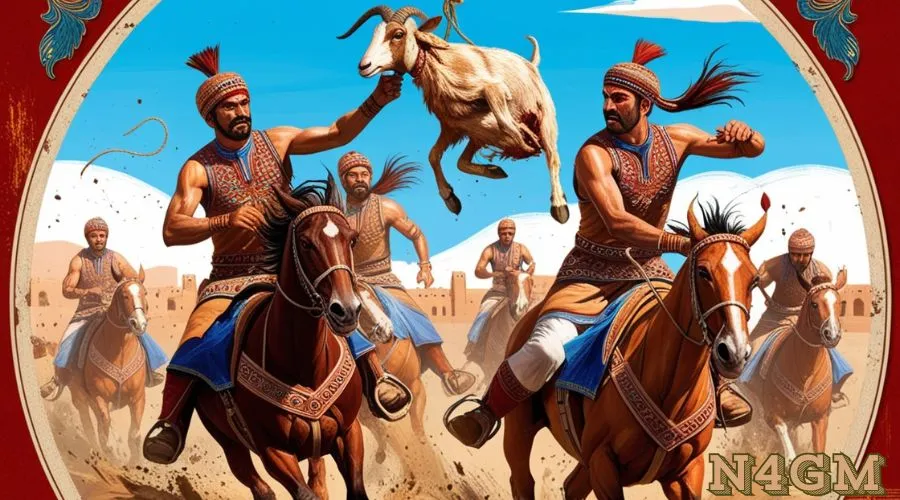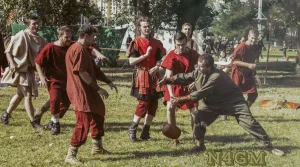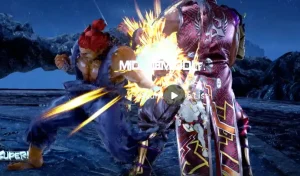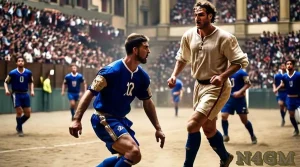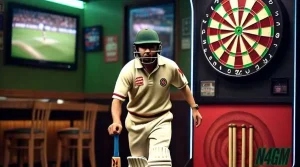So, now let me introduce you to an adrenaline-fueled horse sport known as Buzkashi. It has a huge following in Central Asia. This is an ancient and intense Central Asian game, unlike any sport you’ve ever seen.
It is a sport probably dating back to Islamic times in which people on horseback try to capture a goat or calf carcass and the side with the most carcasses wins. This sport started a long time ago and is still part of the culture of Afghanistan, Tajikistan, Kyrgyzstan, and Kazakhstan.
In this article, I will define Buzkashi, look at its history, the actual game, and some of the strategies involved. I will also look at the cultural relevance as well as compare it to similar sports.
Buzkashi: Central Asian Game
Buzkashi, literally translated from Persian, means goat-grabbing. It is a dangerous game in which the players called “Chapandaz” try to capture a goat or a calf carcass and carry it across a goal line.
It is a game that has been in existence for decades in central Asia, and like most games, it has undergone demolition. The rules may also differ according to the region. But the game’s essence is the same: two teams on horseback fight to control a carcass and take it to the scoring area.
It is also referred to as rugby, polo, and wrestling, incorporating the use of horses. The game is not only a sport but also a cultural one that gathers people together.
Origins
1. Early Turkic Tribes: The Birthplace
Buzkashi or ‘horse wrestling,’ is believed to be the oldest traditional sport of Central Asia. It has roots deep within the background of the early nomadic Turkic people.
Originally, it was practiced as a form of physical training for warriors and more specifically as a means for them to move swiftly and in unison across the battlefield.
This sport was used to enhance some significant skills among the fighters. They required muscle power, stamina, and horse riding skills. This training was quite crucial in a period when man was a nomadic being and his life was tough.
2. Genghis Khan And The Mongol Connection
There are historians who argue that this game has its roots in the Genghis Khan and the Mongol Empire eras. It assisted the soldiers in maneuvering in the course of the warfare while on horseback.
It enhanced their capacity in the conduct of warfare by improving how they might approach a battlefield.
3. A Test Of Strength, Dexterity, And Courage
It was not only a game, but it meant something more than this to the people of that period. They signified power, flexibility, and bravery among the Bushmen.
The Central Asian nomads had a very high regard for these principles. They provide the framework of the region’s warrior values.
4. The Masculinity And Prestige
Regarding the relation between this and social norms and values, the activity is associated with masculinity and prestige in some Central Asian cultures. It requires great skill to emerge a winner in the game. It earned respect in the community.
5. The National Sport
In Afghanistan, it holds a special place in the cultural and sporting landscape. It is a national sport. It draws large crowds who admire the players’ skills and the game’s excitement.
6. A Symbol Of Central Asian Heritage
Buzkashi, a cherished regional tradition, links us to Central Asia’s rich culture. Its popularity endures. It shows the values of strength, unity, and resilience in modern times.
Rules And Gameplay
1. Basic Rules
While rules can vary greatly by region, some are common. Here are some that are generally observed:
Players:
- It can be played by individuals or teams. In team games, each team typically consists of 8 to 12 riders.
- In some variations, hundreds of riders may compete simultaneously.
The Carcass:
- A headless goat or calf carcass is used as the “ball.” The weight of the carcass can range from 25 to 50 kilograms (55 to 110 pounds).
- Players can’t strap the carcass to their saddles. They must hold it with their hands or wrap it with their legs.
Objective:
- The goal is to take the carcass from the scrum and carry it to a marked scoring area, like flags or circles.
Gameplay:
- Players must remain mounted on their horses at all times.
- Players can use whips on their own horses and those of their opponents. They cannot strike other players directly. Physical contact is allowed.
Duration:
- Matches can last anywhere from a few minutes to several hours, depending on local customs.
- Some organized games are divided into periods, typically lasting around 20 minutes each.
Judging and Referees:
- Many informal games do not have referees. However, organized matches often have judges who oversee the game and enforce rules.
Variations
It has several regional variations that reflect local traditions:
- Tudabarai: This version is often played without formal teams. Riders compete to grab the carcass. They can then move freely until they are clear of other players.
- Qarajai: In this format, players must carry the carcass around a marker. Then, they must throw it into a scoring circle. Teams usually consist of fewer riders compared to Tudabarai.
- Kokpar: A variant popular in Kazakhstan that shares similarities with it but has its own specific rules and gameplay style.
Gameplay Dynamics
It is characterized by its chaotic nature. Here’s how a typical game unfolds:
The Scrum:
- The game often begins with a chaotic scrum where players jostle for position to grab the carcass.
- This initial struggle can be intense. Riders use strategy and strength to gain control.
Carrying the Carcass:
- Once a player has secured the carcass, they must avoid other riders while trying to reach the scoring area.
- Players use tactics like speed, agility, and teamwork to outmaneuver opponents. This is in team formats.
Scoring Points:
- Points are scored by successfully placing the carcass in the designated scoring area.
- In some versions, players must complete specific tasks (like circling a flag) before scoring.
Physicality and Strategy:
- Physical contact is common; riders use their bodies and whips to fend off opponents.
- Strategic positioning and timing are crucial for success in this game.
Safety Considerations
Given its rough nature, safety is a significant concern in this Central Asian game:
- Riders often wear helmets and heavy clothing for protection. This gear shields them from injuries due to falls or collisions.
- Despite these precautions, injuries are common due to the aggressive gameplay style.
Strategies
- Positioning: Riders must position themselves to access the carcass in the initial scrum. Good positioning can mean the difference between winning and losing.
- Teamwork: In team games, players often form temporary alliances. They block opponents and help teammates reach the scoring area.
- Horse Control: Mastery of horse riding is crucial. Riders must be able to maneuver their horses quickly and effectively to dodge opponents and navigate the field.
- Endurance: Matches can be physically demanding. Players must keep their stamina to outlast opponents, especially in long games.
- Psychological Warfare: Players often use tactics to unnerve opponents. They might feign weakness or use intimidation.
Challenges
- Declining Horse Ownership: As urbanization increases, fewer people own horses, which impacts participation in the sport.
- Political instability: Conflicts in Afghanistan and nearby areas can disrupt events and tournaments.
- Cultural shifts: Modernization and changing lifestyles may lead to a decline in interest among younger generations.
- Safety Concerns: The rough nature of the game can lead to injuries, raising concerns about player safety.
Compared To Other Sports
1. Polo
At first glance, it might look similar to polo, as both are played on horseback. However, polo is a peaceful game. Players hit a ball into a goal. Buzkashi is much more aggressive.
The lack of rigid rules and the physicality involved make it closer to a combat sport. Polo focuses on finesse, whereas it emphasizes raw strength and endurance.
2. Rugby
This Central Asian game is similar to rugby. Both involve teams fighting to carry an object across a goal line. In rugby, it’s a ball. In this, it’s a carcass.
However, it is more chaotic, with fewer defined boundaries and rules. In rugby, teamwork and passing are key. In the horse game, it’s often every man for himself. Players focus on individual strength.
3. American Football
Like American football, this game requires players to carry an object toward a goal while opponents try to block and tackle them. But Buzkashi has no set positions or plays like in American football. Instead, it relies on the instincts of the Chapandaz and the power of their horses.
Conclusion
It is a thrilling cultural sport. It showcases the strength and skill of its players. Its deep roots in Central Asian history attest to the region’s values and traditions. Despite challenges, the game thrives.
It unites communities and celebrates competition. As it evolves, it stays vital to Central Asia’s culture. This will ensure its legacy endures for generations.

